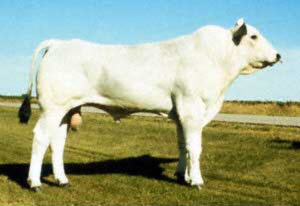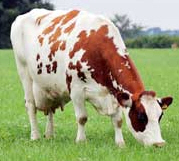



Chianina
History
The Chianina (pronounced kee-a-nee-na) may well be one of the oldest breeds of cattle in existence. They were praised by the Georgic poets, Columella and Vergil, and were the models for Roman sculptures. The breed originated primarily in the west central part of Italy and was found in a wide variety of environmental conditions. Because of this, the cattle vary in size and type from region to region. The largest representatives of the breed, from the plains of Arezzo and Siena, have supplied most of the foundation stock that has been used in the United States and Canada. The name comes from the Chiana Valley in the province of Tuscany in Central Italy which is where Chianti wine is made.Until recent times the Chianina were used primarily as draft animals in their homeland. With the advent of modern mechanized farming practices they selection emphasis has been placed on the breeds ability to produce beef. The earlier selection for work animals had produced a very large breed with considerable length of leg, good action, and heavy muscling. Good dispositions were also desired in the draft animals. The later selections for beef production has maintained the size of the breed and improved the rate of growth.
U.S. servicemen, stationed in Italy during World War II, discovered Chianina. In 1971, Chianina genetics were introduced to the U.S. when the first semen was imported from Italy. Diaceto I was the first Italian fullblood bull to be collected.
For the first few years, Chianina genetics were attainable only through semen. United States Department of Agriculture regulations prohibited the importation of cattle from countries having Foot and Mouth disease, and Italy was one of those countries. A private quarantine station was established in Italy where semen was collected, processed and shipped to breeders in the U.S. For a one year period, 17 young Chianina bulls were admitted and their semen collected.
The breed played a part in upgrading other Podolian breeds, such as the Romagnola, Marchigiana, and Italian Podolian, and it was used in the breeding of the Maremmana and Modicana, while crossbreeding with Swiss Brown cattle resulted in the Pisana.
The Chianina is now being used as a terminal sire for beef producers and it has also been combined with other breeds to create more composites such as the Chiangus, Chimaine and the Chiford.
Characteristics
 Photo courtesy of Oklahoma State University, www.ansi.okstate.edu |
The short horns curve forward and are usually black in the younger animals but become lighter, beginning at the base, as the animals mature.
The most noticeable characteristic of the breed is the extensive and well-defined muscling. The shoulders, back and rear quarters are especially well formed. The legs are longer than most breeds and the bodies are not proportionally as long as some breeds that have shorter legs. The faces are rather long and straight. These characteristics give a distinctive appearance.
The average Chianina cow stands 150-160 cm at the withers and weighs 800-1,000 kg, while the bull measures 160-175 cm, weighing 1,150-1,280 kg. Cows over 160 cm and bulls over 180 cm are not uncommon.
The herds they are used in are frequently crossbred and the Chianina bulls provide an outstanding growth rate in the offspring of these crossbred females.
Cows of the breed often have small udders and are not noted for their milk production. This is not surprising as they were originally valued for draft and later for meat production. Chianinas are late-maturing, and are therefore suitable for production of yearling and older beef.
The Chianina breed has an unsurpassed capacity for lean meat production. The meat is red and is free from waste but still retains a marbling of fat among the muscling. They are renowned for their large eye muscle.
An interesting fact, Chianina calves are born a fawn colour, and turn white between 30 and 260 days.
Statistics
Chianina are great for a variety elements and are generally used as a terminal sire to create great cross calves. Chianinas have:Comparative
Phenotypic relationships between longevity, type traits, and production in Chianina beef cattle, PDF formatRelationship between profitability and type traits and derivation of economic values for reproduction and survival traits in Chianina beef cows, PDF format
Distribution
Chianina cattle can be found in Italy, Australia, New Zealand, the US and Canada.References (the above information was cited from the following sites)
www.ansi.okstate.edu
www.chicattle.org
www.cattlenetwork.net
cattle-today.com


